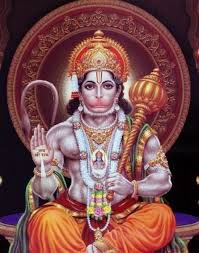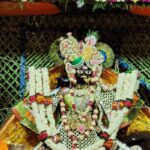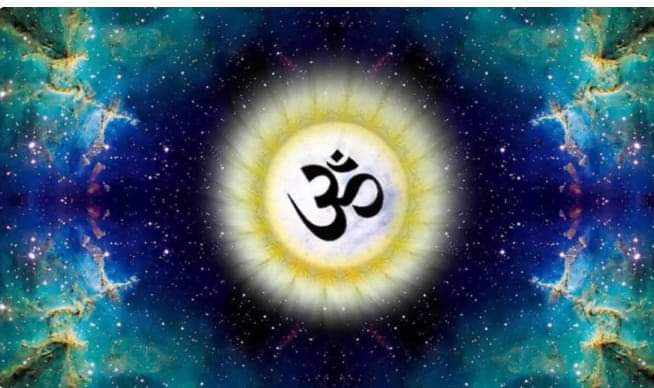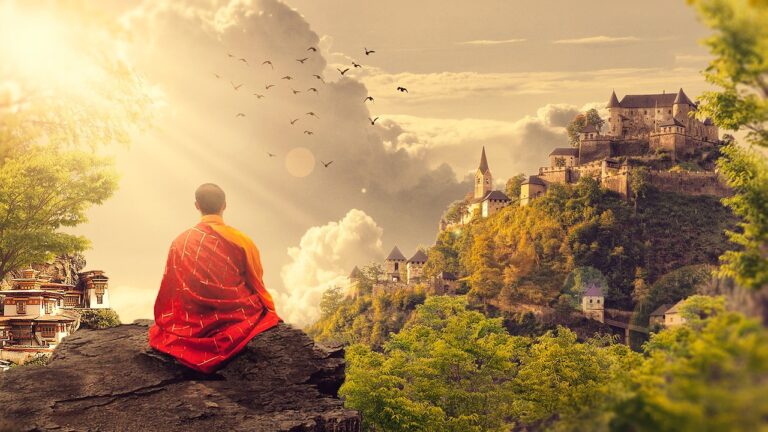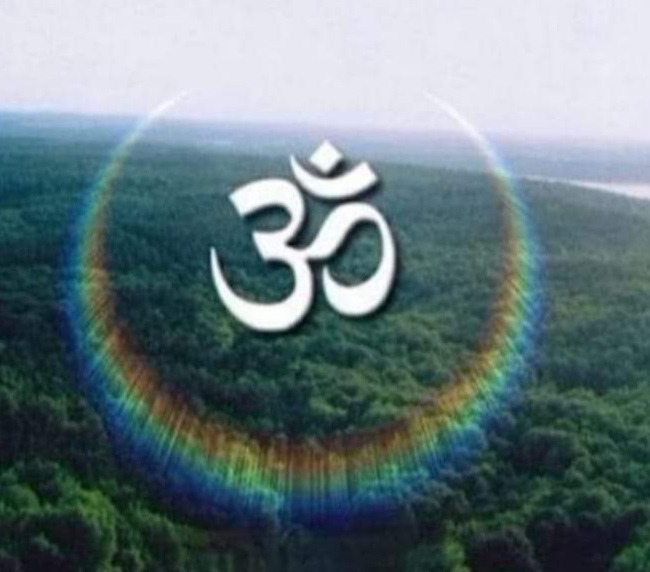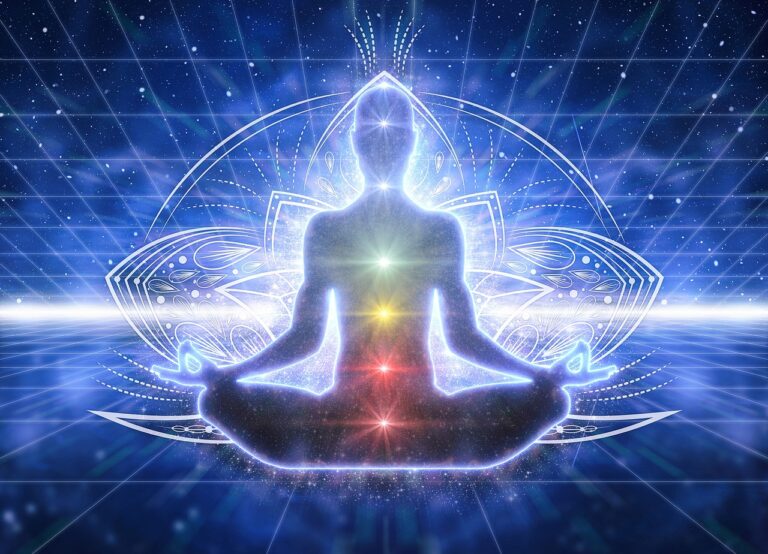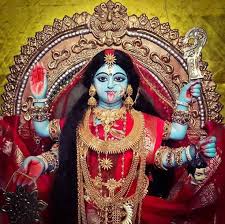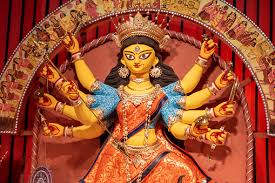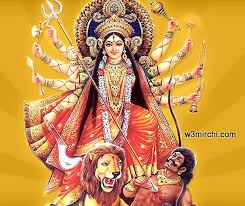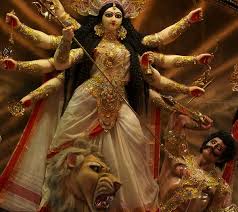।। नमो आञ्जनेयम् ।।
हनुमानजी द्वारा चारों युगों के धर्मों का वर्णन के बारे में महाभारत वनपर्व के ‘तीर्थयात्रापर्व’ के अंतर्गत अध्याय १४९ में बताया गया है, जिसका उल्लेख निम्न प्रकार है-
वैशम्पायन जी कहते हैं- जनमेजय ! हनुमानजी के समझाने पर प्रतापी वीर महाबाहु भीमसेन के मन में बड़ा हर्ष हुआ। उन्होंने बड़े प्रेम से अपने भाई वानरराज हनुमान को प्रणाम करके मधुर वाणी में कहा- ‘अहा! आज मेरे समान बड़भागी दूसरा कोई नहीं है, क्योंकि आज मुझे अपने ज्येष्ठ भ्राता का दर्शन हुआ है।’ आर्य! आपने मुझ पर बड़ी कृपा की है। आपके दर्शन से मुझे बड़ा सुख मिला है। अब मैं पुनः आपके द्वारा अपना एक और प्रिय कार्य पूर्ण करना चाहता हूँ। ‘वीरवर! मकरालय समुद्र को लांघते समय आप ने जो अनुपम रूप धारण किया था, उसका दर्शन करने की मुझे बड़ी इच्छा हो रही है। उसे देखने से मुझे संतोष तो होगा ही, आपकी बात पर श्रद्धा भी हो जायेगी।’
भीमसेन के ऐसा कहने पर महातेजस्वी हनुमानजी ने हंसकर कहा- ‘भैया! तुम उस स्वरूप को नहीं देख सकते; कोई दूसरा मनुष्य भी उसे नहीं देख सकता। उस समय की अवस्था कुछ और ही थी, अब वही नहीं है।
हनुमान जी कहते है- सत्ययुग का समय दूसरा था तथा त्रेता और द्वापर का दूसरा ही है। यह काल सभी वस्तुओं को नष्ट करने वाला है। अब मेरा वह रूप है ही नहीं। पृथ्वी, नदी, वृक्ष, पर्वत, सिद्ध, देवता और महर्षि- ये सभी काल का अनुसरण करते हैं। प्रत्येक युग के अनुसार सभी वस्तुओं के शरीर, बल और प्रभाव में न्यूनाधिकता होती रहती है। अतः कुरुश्रेष्ठ! तुम उस स्वरूप को देखने का आग्रह न करो।
मैं भी युग का अनुसरण करता हूं, क्योंकि काल का उल्लंघन करना किसी के लिये भी अत्यन्त कठिन है। भीमसेन ने कहा- कपिप्रवर! आप मुझे युगों की संख्या बताइये और प्रत्येक युग में जो आचार, धर्म, अर्थ एवं काम के तत्त्व, शुभाशुभ कर्म, उन कर्मों की शक्ति तथा उत्पति और विनाशादि भाव होते हैं, उनका भी वर्णन कीजिये।
हनुमान जी बोले- तात ! सबसे उत्तम कृतयुग है। उसमें सनातन धर्म की पूर्ण स्थिति रहती है। उसका कृतयुग नाम इसलिये पड़ा है, कि उस उत्तम युग के लोग अपना सब कर्तव्य कर्म सम्पन्न ही कर लेते थे। उनके लिये कुछ करना शेष नहीं रहता था उस समय धर्म का हास नहीं होता था। प्रजा का अर्थात माता-पिता के रहते हुए संतान का नाश नहीं होता था। तदनन्तर काल क्रम से उसमें गौणता आ गयी। तात! कृतयुग में देवता, दानव, गन्धर्व, यक्ष, राक्षस और नाग नहीं थे अर्थात ये परस्पर भेद-भाव नहीं रखते थे। उस समय क्रय-विक्रय का व्यवहार भी नहीं था। ऋक, साम और यजुर्वेद मंत्रवर्णो का पृथक-पृथक विभाग नहीं था। कोई मानवी क्रिया कृषि आदि भी नहीं होती थी। उस समय चिन्तन करने मात्र से सबको अभीष्ट फल की प्राप्ति हो जाती थी।
सत्ययुग में एक ही धर्म था, स्वार्थ का त्याग। उस युग में बीमारी नहीं होती थी। इन्द्रियों में भी क्षीणता नहीं आ पाती थी। कोई किसी के गुणों में दोष-दर्शन नहीं करता था। किसी को दुःख से रोना नहीं पड़ता था और न किसी में घमंड़ था तथा न कोई अन्य विकार ही होता था। कहीं लड़ाई-झगड़ा नहीं था, आलसी भी नहीं थे। द्वेष, चुगली, भय , संताप, ईर्ष्या और मात्सर्य भी नहीं था। उस समय योगियों के परम आश्रय और सम्पूर्ण भूतों की अन्तरात्मा परब्रह्मस्वरूप भगवान नारायण का वर्ण शुक्ल था। सत्ययुग के मनुष्य आदि प्राणियों में दोषों का अभाव बतलाया है, उसका यह अभिप्राय समझना चाहिये कि अधिकांश में उनमें इन दोषों का अभाव था।
ब्राह्मण, क्षत्रिय, वैश्य और शूद्र सभी शम-दम आदि स्वभाव सिद्ध शुभ लक्षणों से सम्पन्न थे। सत्ययुग में समस्त प्रजा अपने-अपने कर्तव्यों में तत्पर रहती थी। उस समय परब्रह्म ही सब के एकमात्र आश्रय थे। उन्हीं की प्राप्ति के लिए सदाचार का पालन किया जाता था। सब लोग एक परमात्मा का ही ज्ञान प्राप्त करते थे। समस्त वर्णों के मनुष्य परब्रह्म परमात्मा के उदेश्य से ही समस्त सत्कर्मों का अनुष्ठान करते थे और उस प्रकार उन्हें उत्तम धर्म-फल की प्राप्ति होती थी। सब लोग सदा एक परमात्म देव में ही चित लगाये रहते थे। सब लोग एक परमात्मा के ही नाम का जाप और उन्हीं की सेवा पूजा किया करते थे। सबके वर्णाश्रमानुसार पृथक-पृथक धर्म होने पर भी वे एकमात्र वेद को ही मानने वाले थे और एक ही सनातन धर्म के अनुयायी थे।
सत्ययुग के लोग समय-समय पर किये जाने वाले चार आश्रमसम्बन्धी सत्कर्मों का अनुष्ठान करके कर्म फल की कामना और आसक्ति न होने के कारण परम गति प्राप्त कर लेते थे। चित्तवृत्तियों को परमात्मा में स्थापित करके उनके साथ एकता की प्राप्ति कराने वाला यह योग नामक धर्म सत्ययुग का सूचक है। सत्ययुग में चारों वर्णों का यह सनातन धर्म चारों चरणों से सम्पन्न- सम्पूर्ण रूप से विद्यमान था। यह तीनों गुणों से रहित सत्ययुग का वर्णन हुआ।
अब त्रेता का वर्णन सुनो, जिसमें यज्ञ-कर्म का आरम्भ होता है। उस समय धर्म के एक चरण का हास हो जाता है और भगवान अच्युत का स्वरूप लाल वर्ण का हो जाता है। लोग सत्य में तत्पर रहते हैं। शास्त्रोक्त यज्ञक्रिया तथा धर्म के पालन में परायण रहते हैं। त्रेतायुग में ही यज्ञ, धर्म तथा नाना प्रकार के सत्कर्म आरम्भ होते हैं। लोगों को अपनी भावना तथा संकल्प के अनुसार वेदोक्त कर्म तथा दान आदि के द्वारा अभीष्ट फल की प्राप्ति होती है। त्रेतायुग के मनुष्य तप और दान में तत्पर रहकर अपने धर्म से कभी विचलित नहीं होते थे। सभी स्वधर्म परायण तथा क्रियावान थे।
द्वापर में हमारे धर्म के दो ही चरण रह जाते हैं, उस समय भगवान विष्णु का स्वरूप पीले वर्ण का हो जाता है और वेद ऋक, यजु, साम और अथर्व- इन चार भागों में बंट जाता है। उस समय कुछ द्विज चार वेंदों के ज्ञाता, कुछ तीन वेदों के विद्वान, कुछ दो ही वेदों के जानकार, कुछ एक ही वेद के पण्डित और कुछ वेद की ऋचाओं के ज्ञान से सर्वथा शून्य होते हैं। इस प्रकार भिन्न-भिन्न शास्त्रों के होने से उनके बताये हुए कर्मों में भी अनेक भेद हो जाते हैं तथा प्रजा तप और दान- इन दो ही धर्मों में प्रवृत होकर राजसी हो जाती है। द्वापर में सम्पूर्ण एक वेद का भी ज्ञान न होने से वेद के बहुत से विभाग कर लिये गये हैं। इस युग में सात्त्विक बुद्धि का क्षय होने से कोई विरला ही सत्य में स्थित होता है। सत्य से भ्रष्ट होने के कारण द्वापर के लोगों में अनेक प्रकार के रोग उत्पन्न हो जाते हैं। उनके मन में अनेक प्रकार की कामनाएं पैदा होती है और वे बहुत-सी दैवी उपद्रवों से भी पीड़ित हो जाते हैं। उन सबसे अत्यन्त पीड़ित होकर लोग तप करने लगते हैं। कुछ लोग भोग और स्वर्ग की कामना से यज्ञों का अनुष्ठान करते हैं। इस प्रकार द्वापरयुग के आने पर अधर्म के कारण प्रजा क्षीण होने लगती है।
तत्पश्चात कलियुग का आगमन होता है। कुन्तीनन्दन ! कलियुग में धर्म एक ही चरण से स्थित होता है। इस तमोगुण की अधिकता को पाकर भगवान विष्णु के श्रीविग्रह का रंग काला हो जाता है। वैदिक सदाचार, धर्म तथा यज्ञ-कर्म नष्ट हो जाते हैं। इति, व्याधि, आलस्य, क्रोध आदि दोष, मानसिक रोग तथा भूख-प्यास का भय- ये सभी उपद्रव बढ़ जाते हैं। युगों के परिवर्तन होने पर आने वाले युगों के अनुसार धर्म का भी हास होता जाता है। इस प्रकार धर्म के क्षीण होने से लोक की सुख-सुविधा का भी क्षय होने लगता है। लोक के क्षीण होने पर उसके प्रवर्तक भावों का भी क्षय हो जाता है। युग-क्षयजनित धर्म मनुष्य की अभीष्ट कामनाओं के विपरीत फल देते हैं। यह कलियुग का वर्णन किया गया, जो शीघ्र ही आने वाला है।
चिरंजीवी लोग भी इस प्रकार युग का अनुसरण करते हैं। शत्रुदमन! तुम्हें मेरे पुरातन स्वरूप को देखने या जानने के लिये जो कौतूहल हुआ है, वह ठीक नहीं हैं। किसी भी समझदार मनुष्य का निरर्थक विषयों के लिये आग्रह क्यों होना चाहिये ? महाबाहों! तुमने युगों की संख्या के विषय में मुझसे जो प्रश्न किया है, उसके उत्तर में मैंने यह सब बातें बतायी हैं। तुम्हारा कल्याण हो, अब तुम लौट जाओ।
।। जय श्रीरामभक्त रुद्रावतार हनुमान ।।
।। Obeisance to Anjaneya.
The description of the religions of the four ages by Hanumanji has been told in chapter 149 under the ‘Pilgrimage Festival’ of the Mahabharata Vanaparva, which is mentioned as follows-
Vaishampayan ji says – Janamejaya! Pratapi Veer Mahabahu Bhimsen’s heart was very happy on the explanation of Hanumanji. He bowed down to his brother Vanaraja Hanuman with great love and said in a sweet voice – ‘Aha! Today there is no one else as fortunate as me, because today I have seen my elder brother.’ Arya! You have done me a great favor. I have got great happiness from your darshan. Now again I want to complete another favorite work of mine through you. ‘Veevar! I have a great desire to see the unique form you assumed while crossing the Makaralay sea. Seeing him will not only give me satisfaction, I will also have faith in your words.’
On Bhimsen saying this, Mahatejaswi Hanumanji laughed and said- ‘Brother! You cannot see that form; No other human being can even see him. The situation at that time was different, it is not the same now.
Hanuman ji says- The time of Satyayuga was different and that of Treta and Dwapar is different. This time is going to destroy all things. Now I don’t have that form at all. Earth, rivers, trees, mountains, siddhas, gods and sages – all these follow Kaal. According to each era, there is a modicum in the body, power and influence of all things. That’s why Kurushrestha! Don’t insist on seeing that form.
I also follow the era, because it is very difficult for anyone to violate time. Bhimsen said – Kapipravar! You tell me the number of ages and also describe the principles of conduct, religion, meaning and work, auspicious deeds, the power of those deeds and the origin and destruction in each age.
Hanuman ji said – Tat! Kritayuga is the best. He has the perfect stage of Sanatan Dharma. It is named Krita Yuga because the people of that Uttam Yuga used to complete all their duties. There was nothing left to do for them, at that time there was no decline of religion. Praja means that the child did not perish while the parents were alive. After that, with the passage of time, there was a secondaryness in it. Tat! In Kritayuga, there were no gods, demons, Gandharva, Yaksha, Rakshasa and Nag, that means they did not differentiate between each other. At that time there was no business of buying and selling. There was no separate division of Rik, Sama and Yajurveda Mantravarnas. There was no human activity like agriculture etc. At that time, just by thinking about it, everyone used to get the desired result.
There was only one religion in Satyayuga, renunciation of selfishness. There was no disease in that era. There was no weakness in the senses also. No one used to see faults in anyone’s qualities. No one had to cry out of sorrow and no one had pride and no other disorder. There was no fighting, neither were they lazy. There was no malice, backbiting, fear, anger, envy and jealousy. At that time, the color of Lord Narayan, the ultimate shelter of the yogis and the inner soul of all the ghosts, the Supreme Brahman, was pure. The absence of defects in humans etc. creatures of Satyayuga has been told, it should be understood to mean that most of them lacked these defects.
Brahmins, Kshatriyas, Vaishyas and Shudras were all endowed with auspicious traits such as Sham-Dum etc. In Satyayuga, all the subjects used to be busy in their respective duties. At that time Parabrahma was the only refuge of all. To achieve them, virtue was followed. Everyone used to get the knowledge of only one God. People of all varnas used to perform rituals of all good deeds for the purpose of Parabrahma Paramatma and in that way they got the best results of religion. All the people always kept their mind fixed on the one Supreme God. Everyone used to chant the name of only one God and worshiped him only. Despite everyone having different religions according to their caste, they believed only in Vedas and were followers of the same Sanatan Dharma.
The people of Satyayuga attained the supreme state by performing the rituals of the four ashram-related good deeds done from time to time, due to lack of desire and attachment to the fruits of their actions. This religion called Yoga, which establishes the mind-sets in the Supreme Soul and achieves unity with Him, is an indicator of the Satyayuga. In Satyayuga, this Sanatan Dharma of all the four varnas was fully present with all the four phases. This is the description of Satyayuga without all the three qualities.
Now listen to the description of Treta, in which the yagya-karma begins. At that time one stage of Dharma is lost and the form of Lord Achyuta becomes of red colour. People are eager in the truth. The scriptures remain devoted to the Yagya Kriya and the observance of religion. Yagya, religion and various types of good deeds start in Tretayug itself. People get the desired fruit according to their feelings and determination through Vedokta karma and charity etc. The people of Tretayug never deviated from their religion by being ready in penance and charity. All were self-righteous and active.
In Dvapar, only two phases of our religion remain, at that time the form of Lord Vishnu becomes yellow and the Vedas are divided into four parts – Rik, Yaju, Sama and Atharva. At that time, some Dwijas are the knower of four Vedas, some are scholars of three Vedas, some are knowledgeable of only two Vedas, some are scholars of only one Veda and some are completely void of knowledge of the hymns of Vedas. In this way, due to the presence of different scriptures, there are many differences in the deeds told by them and the people become royal by being inclined towards the two religions of penance and charity. Due to lack of knowledge of even one complete Veda in Dwapar, many divisions of Vedas have been done. In this era, because of the decay of sattvik intelligence, hardly anyone is situated in the truth. Due to being corrupted by truth, many types of diseases arise in the people of Dwapar. Many types of desires arise in their mind and they also suffer from many divine nuisances. Being extremely afflicted by them, people start doing penance. Some people perform rituals of Yagya with the desire of enjoyment and heaven. In this way, on the arrival of Dwaparayuga, the people start to decrease due to unrighteousness.
After that comes the Kali Yuga. Kuntinandan! In Kaliyuga, religion is based on only one step. The color of Lord Vishnu’s Deity turns black after getting excess of this Tamoguna. Vedic virtues, religion and yagya-karmas are destroyed. Fatigue, disease, laziness, anger etc. defects, mental illness and fear of hunger and thirst – all these nuisances increase. With the change of eras, according to the coming eras, religion also declines. In this way, due to the decay of religion, the happiness and convenience of the people also starts to decay. When the world decays, its promoters also decay. Age-decaying religions give results contrary to the desired wishes of man. This is the description of Kali Yuga, which is going to come soon.
Chiranjeevi people also follow the era like this. Enemy suppression! The curiosity you have to see or know my ancient form is not right. Why should any sensible man have an urge for meaningless subjects? Great arms! I have told all these things in answer to the question you asked me about the number of ages. Good luck to you, now you go back.
।। Jai Shri Rambhakt Rudraavatar Hanuman ।।

